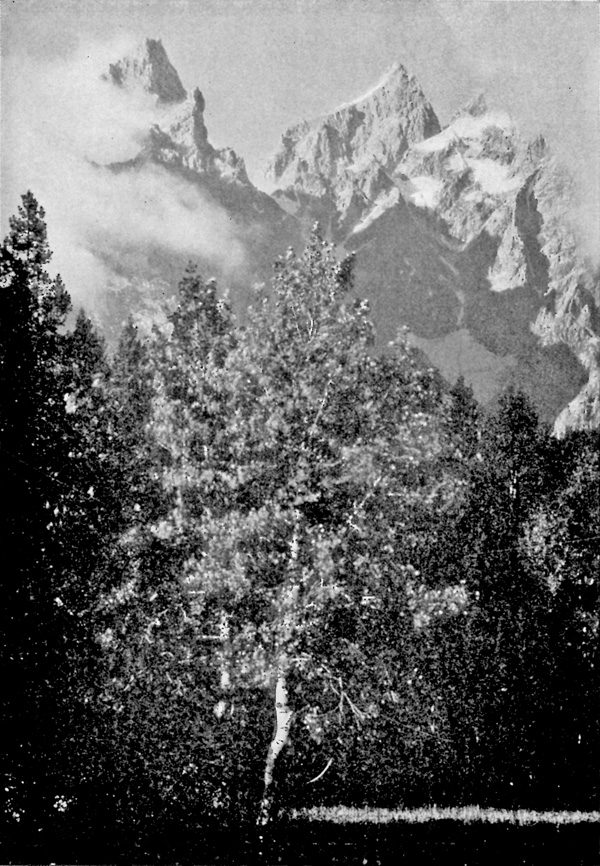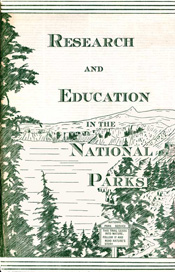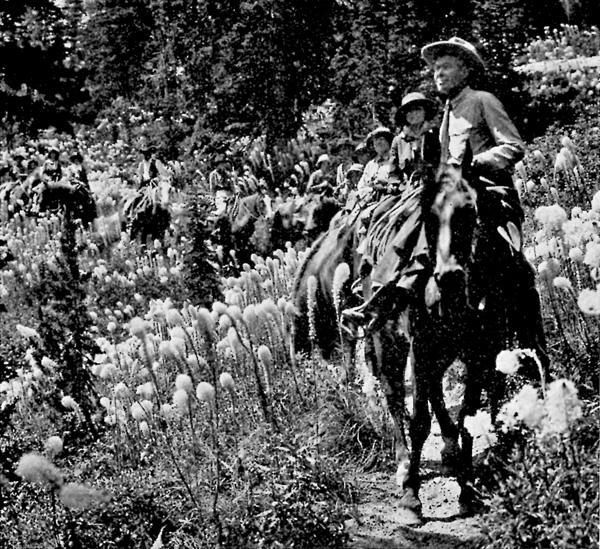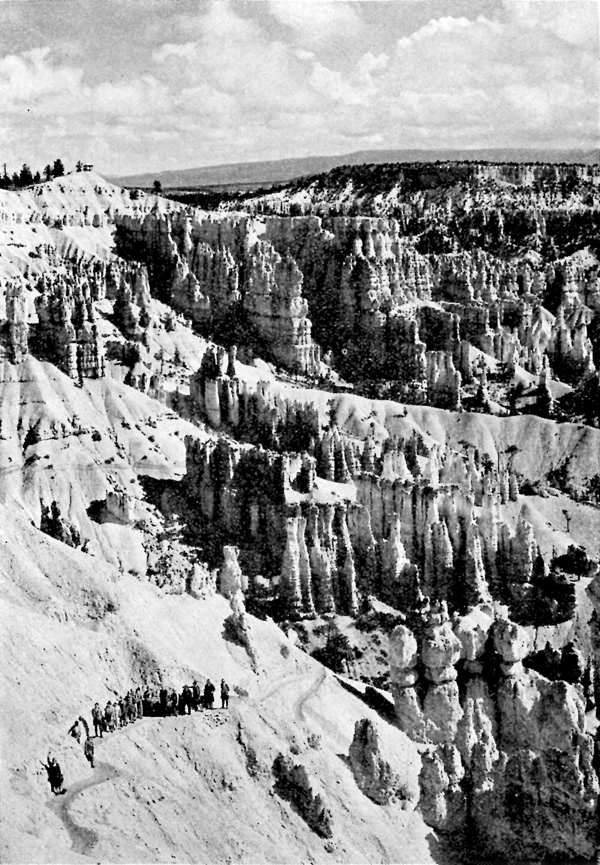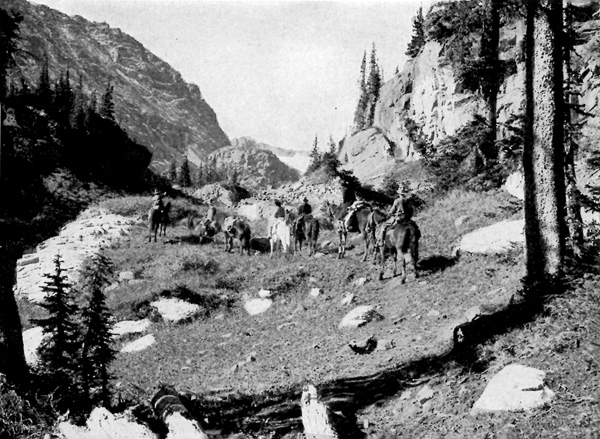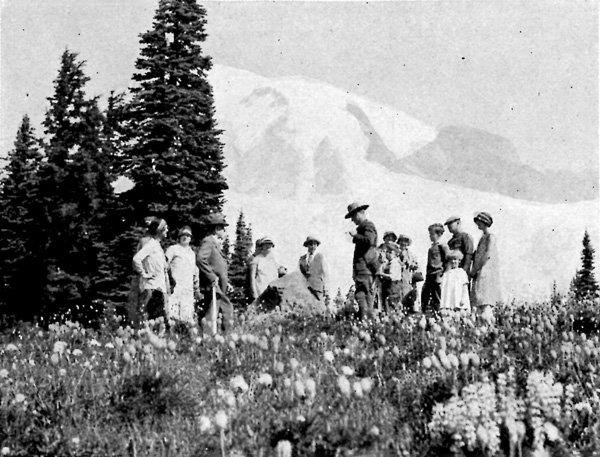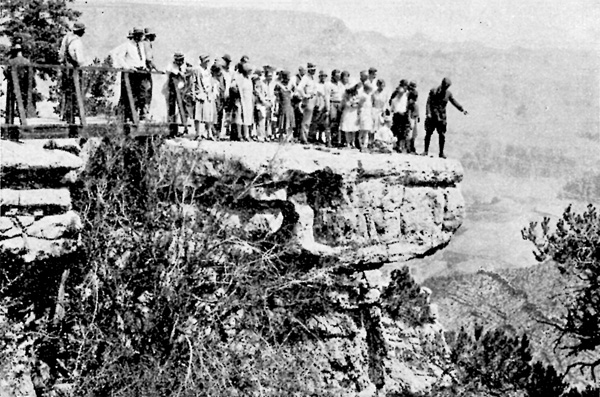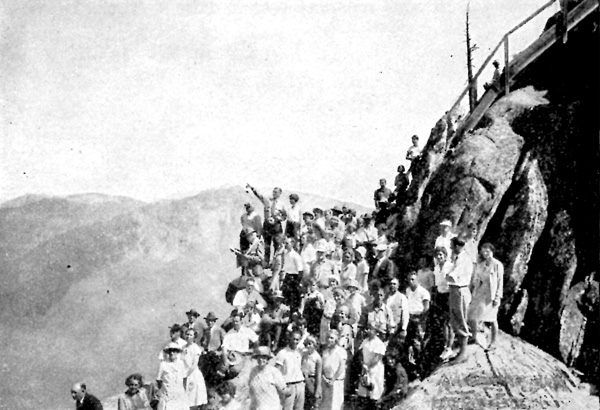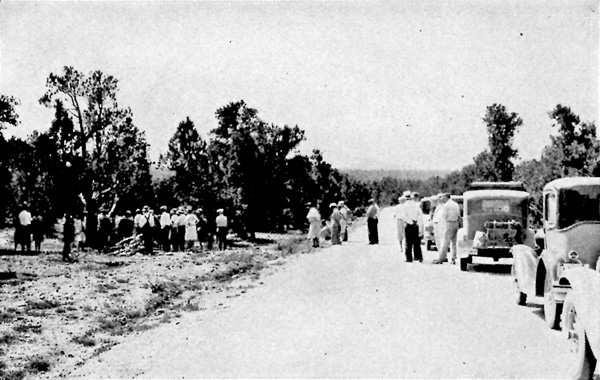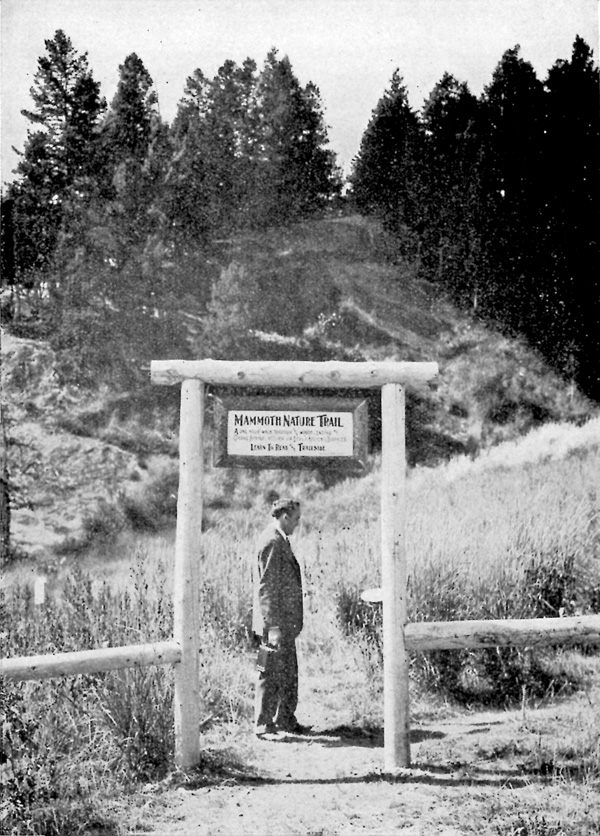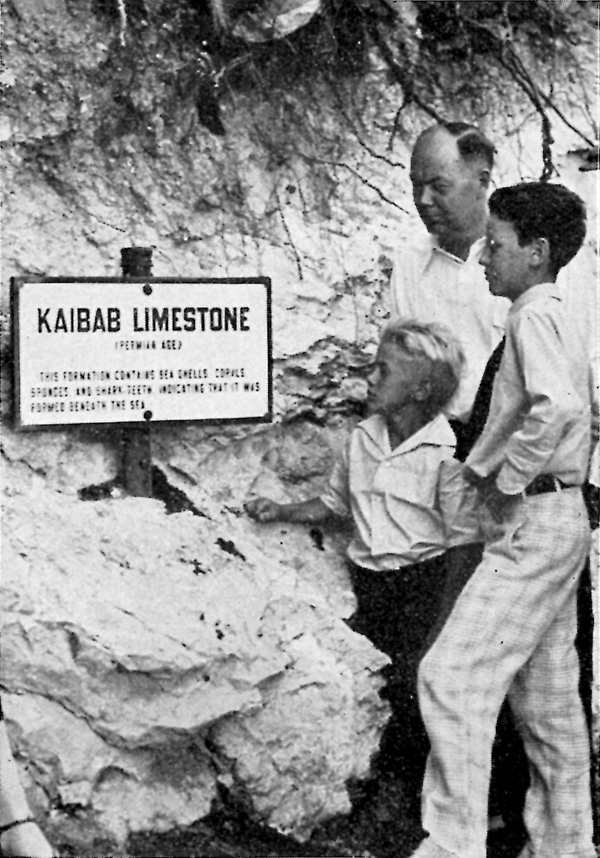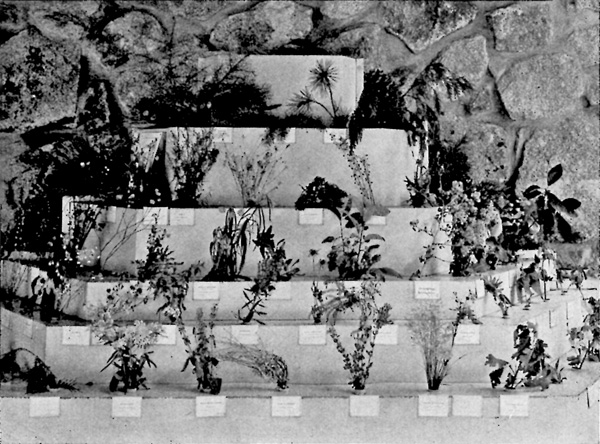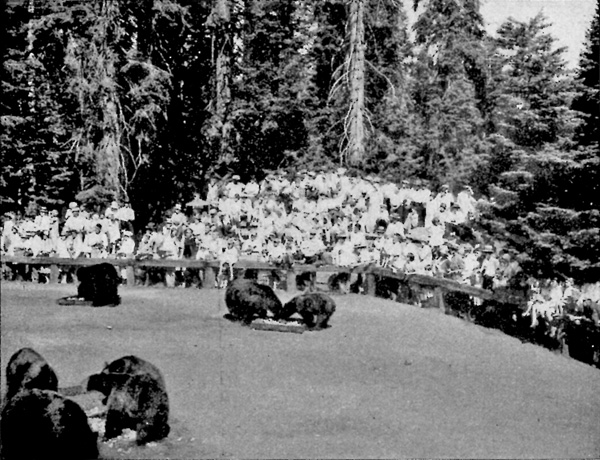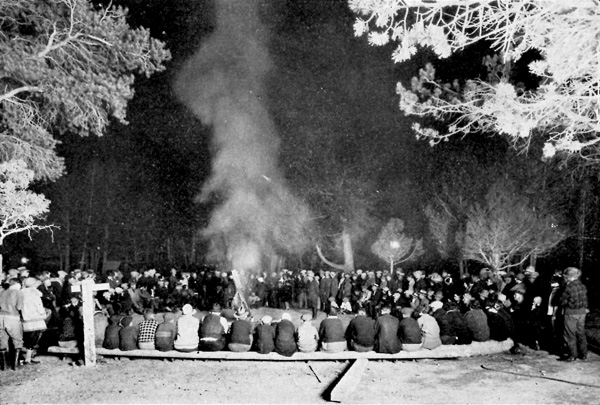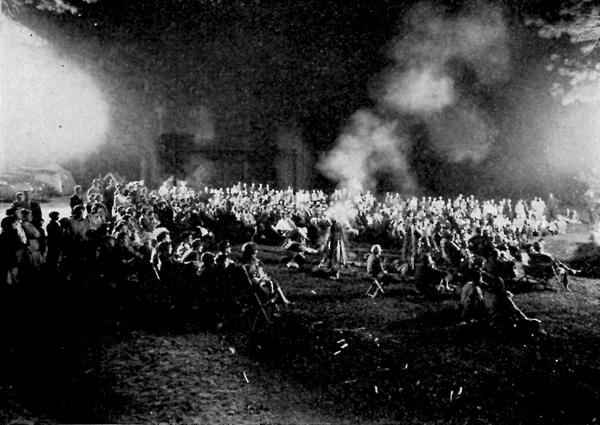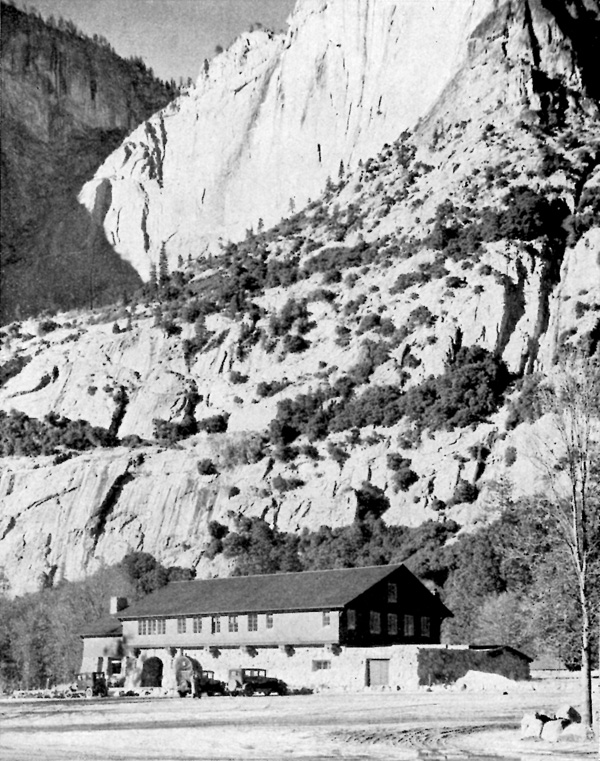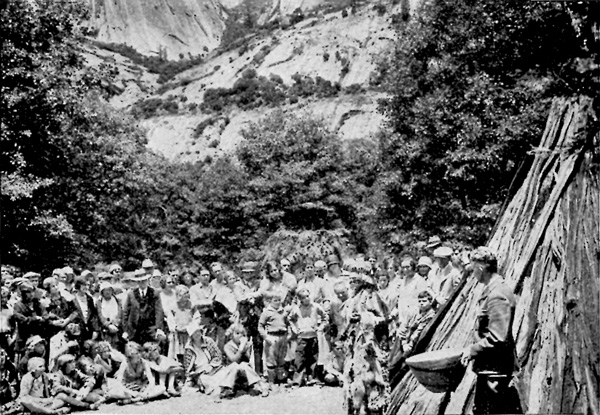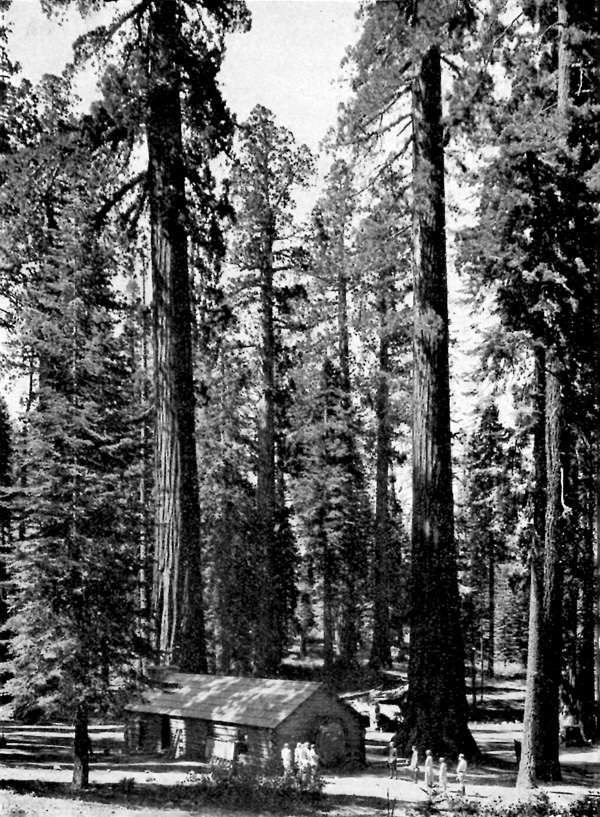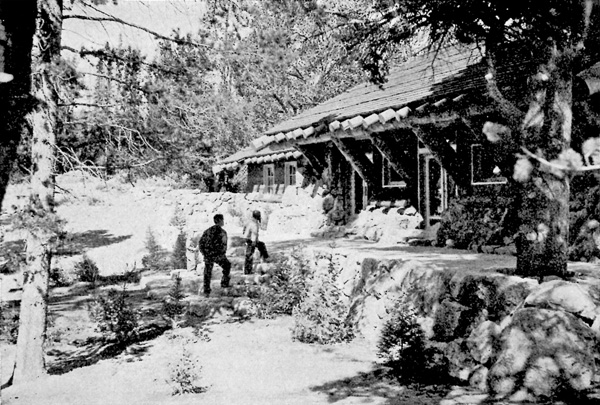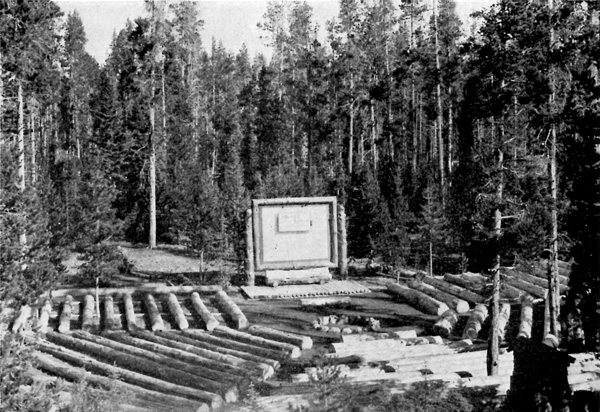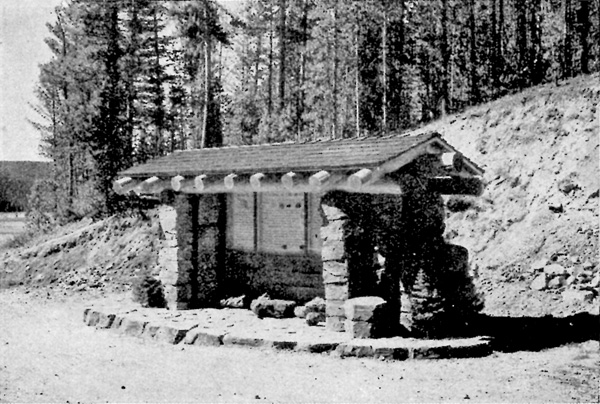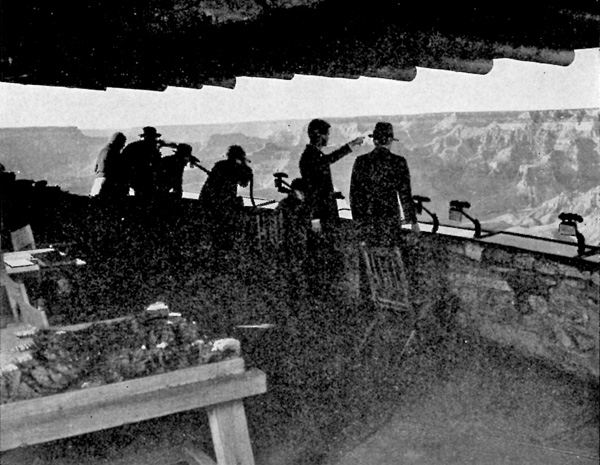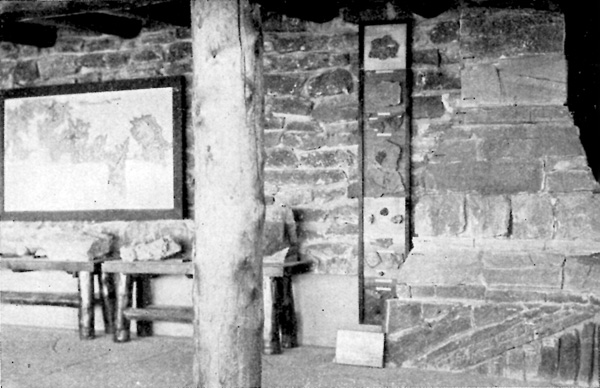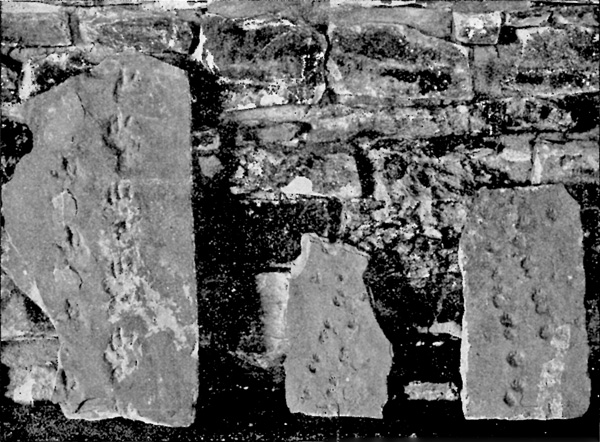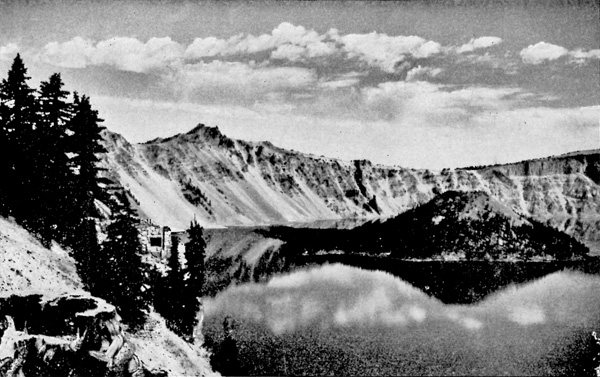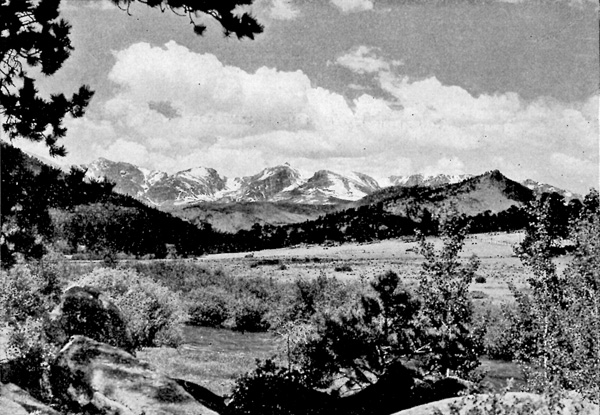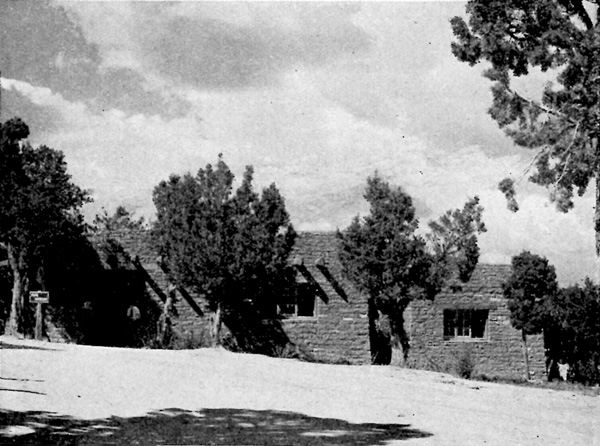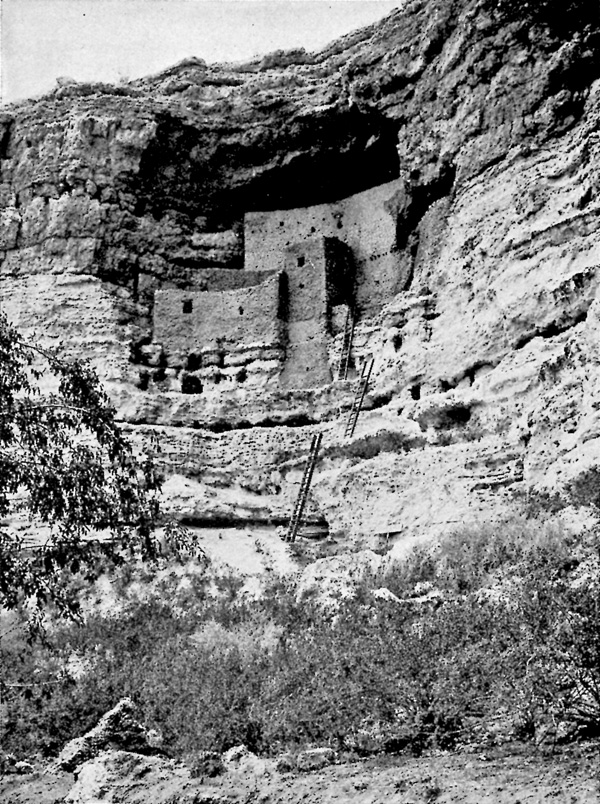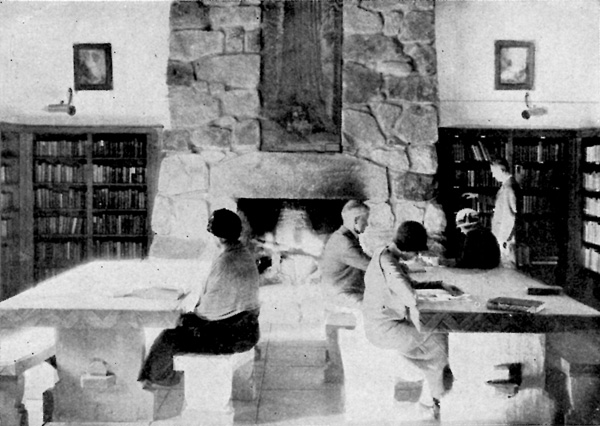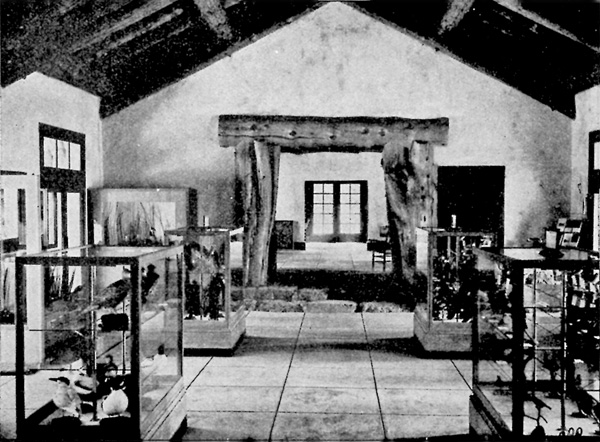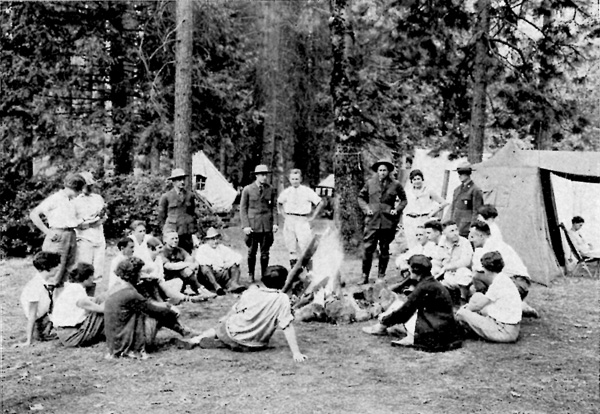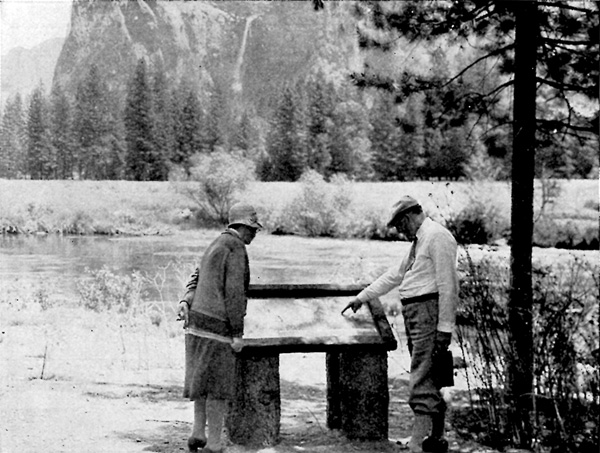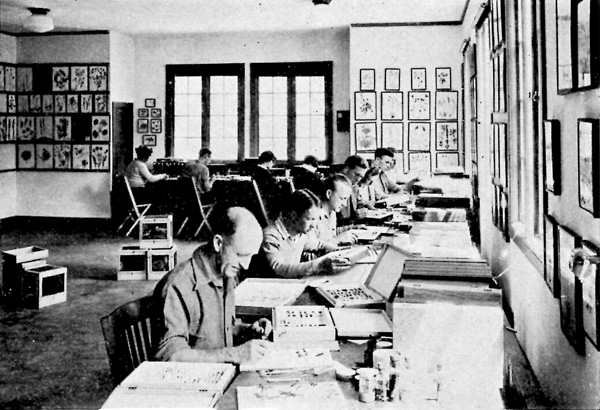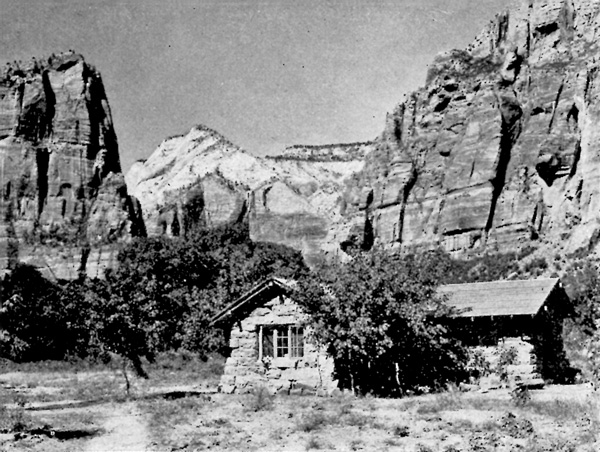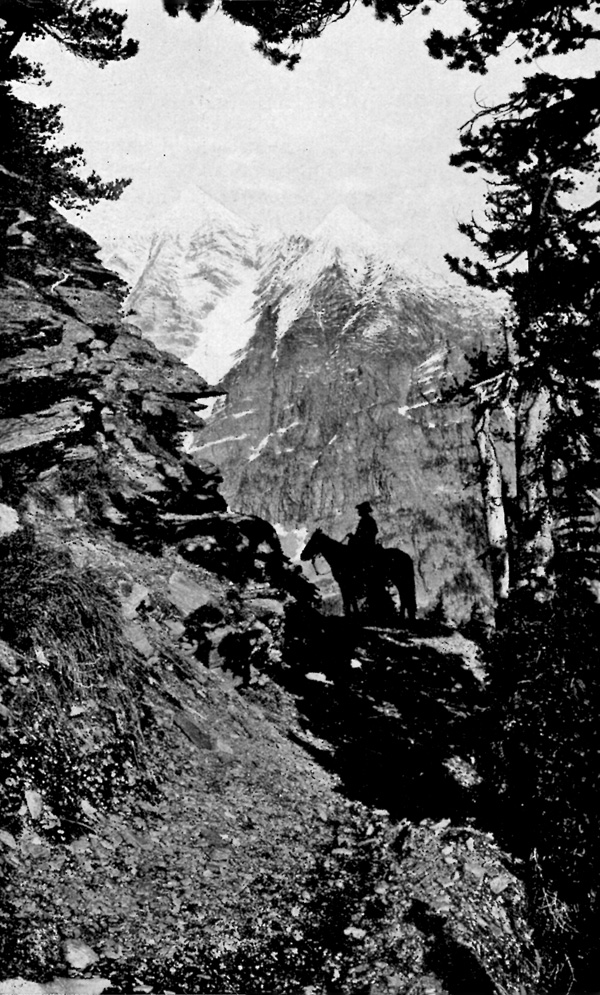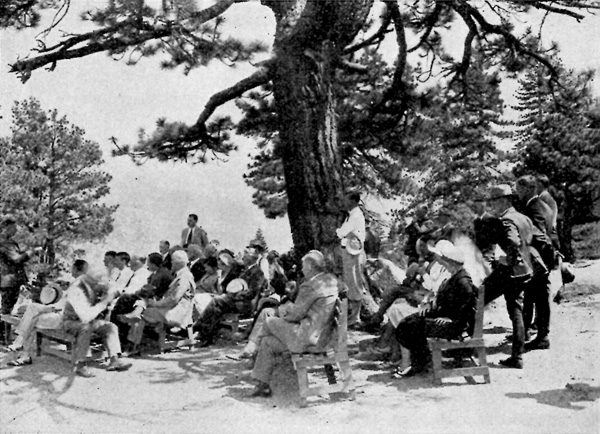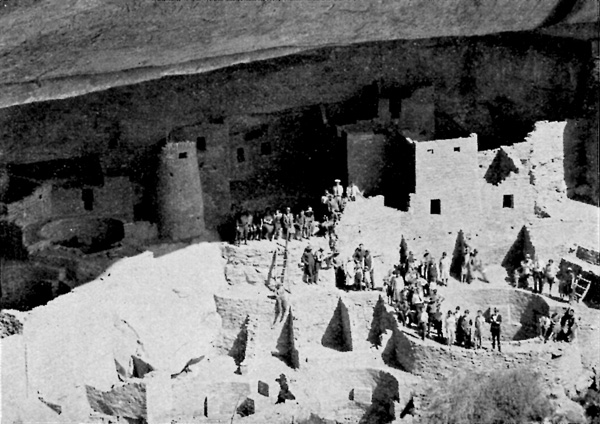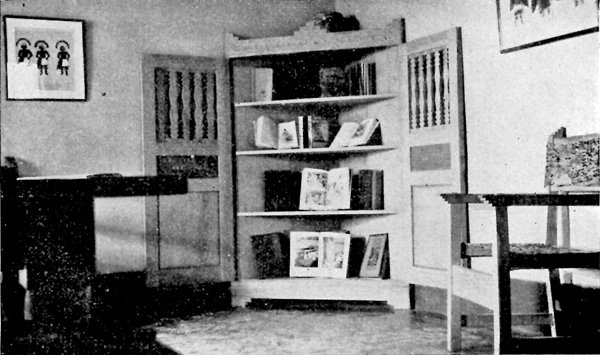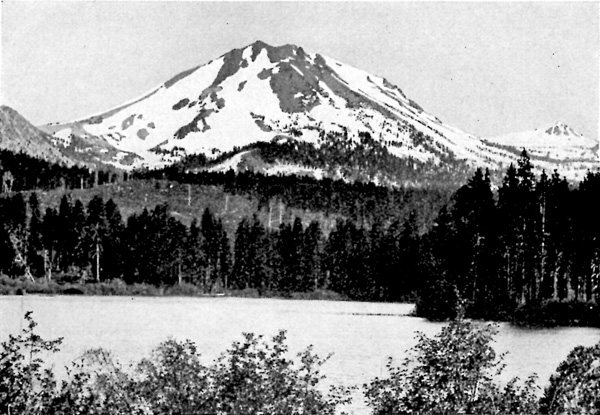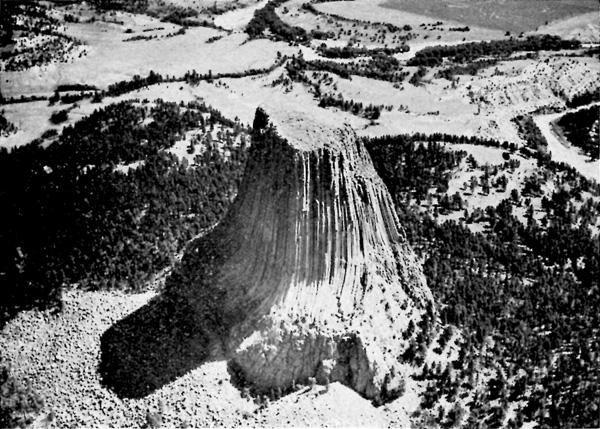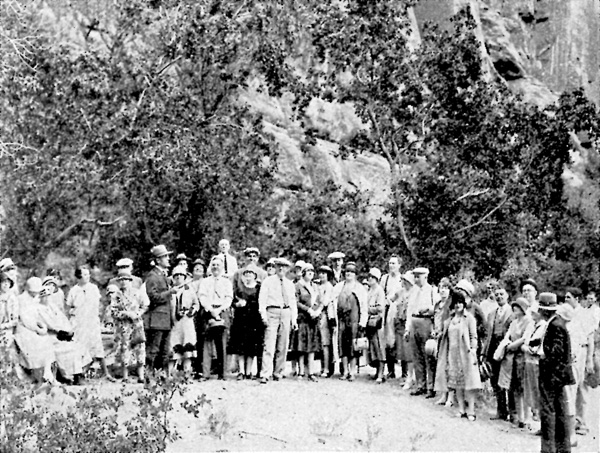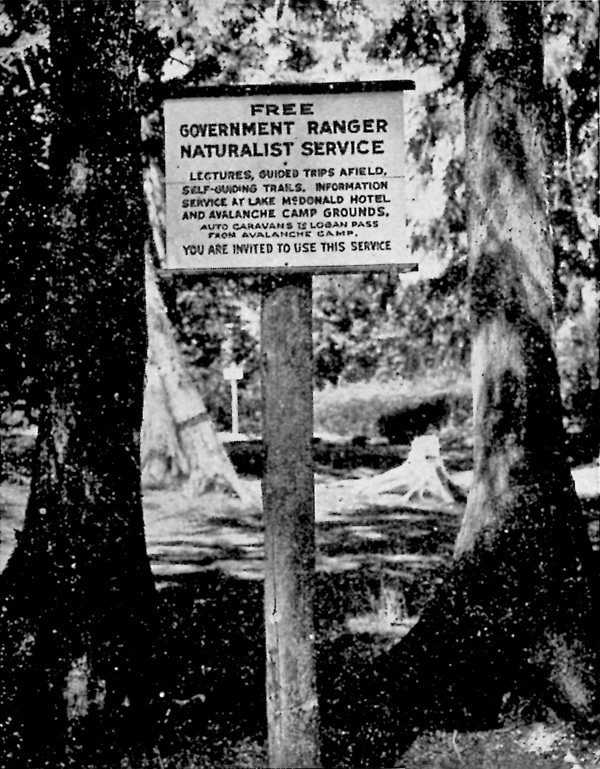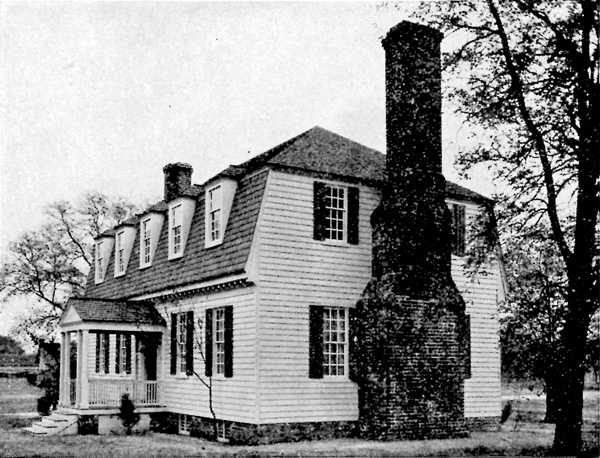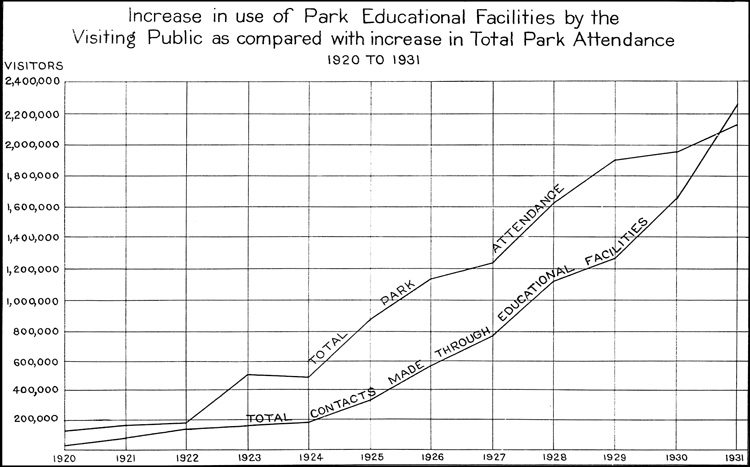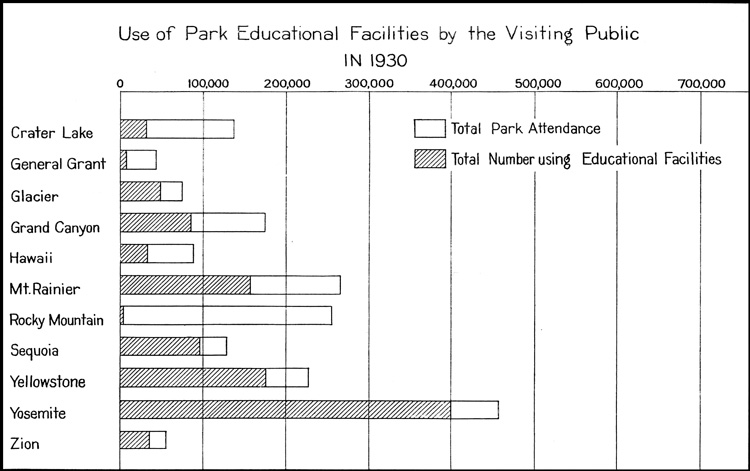
CELEBRATING THE NATIONAL PARK SERVICE CENTENNIAL • 1916-2016
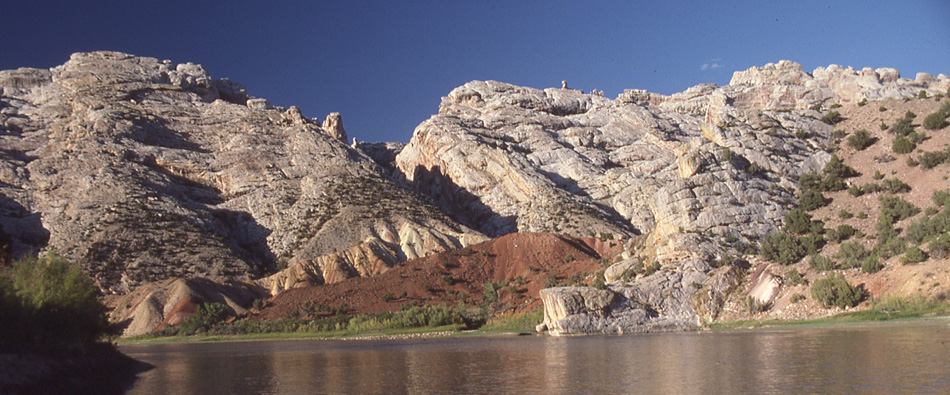
Dinosaur National Monument
|
Research and Education in the National Parks by Harold C. Bryant and Wallace W. Atwood, Jr. 1932
PART I Among the most valuable of this country's assets is the system of national parks now comprising 0.017 per cent of the total land owned by the Government. The establishment of these reserves constitutes one of the most important phases of the conservation movement that has characterized our national life during the past 60 years. The people of the United States have seen the wisdom of preserving in national ownership for posterity the conspicuous and unique natural wonderlands of our country. Complying with the high standards required for the establishment of national parks a remarkable group of reserves has been created for the benefit and enjoyment of the people. These areas are of outstanding value to the Nation because of the permanent inspirational and educational values contained therein. Dr. John C. Merriam, president of the Carnegie Institution of Washington, has defined the use of national parks thus:
To provide each visitor to a national park with an opportunity to interpret and appreciate its superlative features has become the goal of all those interested in the highest use of national parks and has led to the establishment of an educational program to attain this end. In this program there is little that pertains to classrooms, textbooks, or other formal educational methods. The extensive educational program now found in the national parks was brought about as the result of two factors—the need of the average visitor for explanations of major features and the desire of the Park Service to find the highest use of national parks. Both led to emphasis on proper interpretation of the features which characterize the parks.
Nearly every person who visits a national park does so either out of curiosity to see some natural wonder or from a desire to interpret and appreciate superlative features. No matter what the motive there is always awakened a desire to have phenomena explained. Contact with real things, with unusual things awakens a desire for explanation, for an increase of knowledge. This awakened craving for knowledge needs to be satisfied when the desire is uppermost. On the other hand, the National Park Service discovered that in fulfilling its duty to the public the educational and inspirational opportunities must be developed to the fullest and that appreciation of the major features must be actively carried to visitors by means of National Park Service men who have the training to interpret and the enthusiasm to impress the public. As a result opportunity for improving one's knowledge regarding park features is a stabilized service afforded the public in all major parks. The Park Service feels that a contribution is being made to the enrichment of the lives of the park visitor because opportunities are provided whereby the visitor may learn about his natural environment and the laws of life. It is a program that helps to make education a continuous process, that emphasizes avocational pursuits, that stimulates the proper use of leisure time.
The exceptional opportunities for outdoor education available in the national parks are being recognized more and more by scientists and educators throughout the country. Each season numerous college and university classes, science clubs, and nature organizations visit the parks and study the superlative exhibits of geology, biology, history, and archeology. These trips are encouraged by the Service and every effort is made to assure these groups a worth-while program. In addition to this educational use there has grown up an actual educational program. Four years after the establishment of the National Park Service in 1916, field trips and lecture programs were offered free to all visitors to Yosemite National Park. This small beginning, first supported by individuals keenly interested in the educational possibilities of the parks, has grown until now there is a complete field trip, lecture, museum, and research program in all major national parks of the country. The history of this educational movement from the conception of the idea to the establishment of the Branch of Research and Education is told in a later chapter. A discussion of accomplishments is to be considered first.
In the development of the enlarged program of educational activities several main general policies have been followed. Important among these are the following:
Never has there been an idea of making the educational work of purely academic character. Rather has emphasis been placed on a plan to make the work fit the outstanding opportunity—that of stressing first-hand information. Furthermore, the program had to be developed to fit the average park visitor. Lectures and exhibits play their part, but enthusiastic leadership by a nature guide who takes parties afield to study special features is the educational contribution that is unique. The universities may afford better classroom work, better library facilities, and better lectures, but it is believed that nowhere can people find better objective materials for study or receive better training in interpreting phenomena than is afforded when the studdent is in direct contact with nature out of doors. There is hope that new methods in adult education will be discovered, and that the national parks will become the great universities of the out-of-doors for which their superlative scientific exhibits so finely equip them. GUIDED TRIPS In commencing this discussion of the educational work in the parks and monuments. it is quite appropriate to refer first to the guided trip which has been the outstanding feature in its popularization. There is recognition that "Nature is the supreme school-teacher and master textbook." Walking trips, under the escort of ranger naturalists, are routed through areas rich in the natural phenomena especially exemplified in the park, and the features of outstanding interest along the way are pointed out and explained. (See figs. 4 and 5.) In parks and monuments where history is prominent in the educational program, the ranger historians stress first-hand acquaintance with scenes in which major human events have transpired and in this way motivate interest in our historical heritage.
Guided trips vary in length throughout the national park system, from a few hours to those of several days' duration, extending into the mountainous back country. This guide service is offered in all parks where educational work is being carried on. Despite the increase in the educational personnel, it is not possible to handle adequately the increasingly large crowds desiring to take the nature trips. The method stressed is expressed in Agassiz's old dictum : "Study nature, not books." The enthusiasm of a nature guide is contagious. He is able to make a trail side interesting. He brings senses seldom used into prominence. Plants are recognized by odor and taste. Birds are recognized by call-note and song. Trees are recognized by feeling the bark. Geological stories are made plain through careful observation. Leading events in history are made vitally interesting through acquaintance with historic landmarks and remains of ancient civilizations. Too often a study of biology is sought through tedious dissection and microscopic analysis; too seldom is there study of the living thing in its natural environment.
From an educational standpoint, the method (of the field trip has several outstanding advantages: 1. First-hand information involving all five series is available, real experiences are gained, and better concepts obtained. 2. Common interest is gained because of the superlative teaching materials available. There is opportunity to follow the interest of the group. Individual attention is afforded the student. 3. Aesthetic and inspirational values are realized.
Nature guiding is an inspirational method of teaching. To inspire the student to continue to observe carefully is more important than to make new information stick in his mind. To pay a personal visit to an historic shrine is to give a concept such as no book can supply. As a rule, a ranger naturalist or historian has but a couple of hours in which to impress his followers with the possibilities of a trail side. He has done his work well if he has opened their eyes and unstopped their cars, demonstrated how much fun it is to study geologic and historic features and living things first hand, and left a vision of the great natural processes involved. It is interesting to note that in 1930 nuture-guide service was introduced in the Canadian national parks by the Dominion Government. According to the Canadian Department of the Interior, the nature guides' duties "will be simply to open the eyes of the visitors to the interesting things which most of us miss, and to explain their meaning," and "to act as curator of the natural treasures and curiosities of the parks, and to introduce all who are interested to the flowers, trees, birds, butterflies, and rocks which can be seen along the main trails within easy reach of the chief resorts." AUTO CARAVANS One of the most popular innovations in the naturalist program is known as the auto caravan. Visitors driving their own automobiles are conducted to points of special scenic, historic, or scientific interest. Daily caravan trips, under expert guidance of a trained naturalist or historian, are scheduled in all of the major national parks and the demand for this service is increasing rapidly.
NATURE TRAILS The nature trail, carefully selected and labeled, is proving an efficient method of helping visitors to get acquainted with interesting geologic and biologic features. There are many who prefer studying things quietly by themselves, and labeled rocks, trees, and plants fulfill this requisite. In Yosemite National Park short trails have been built and labels placed to indicate the best localities in which glacial polish and striae may be seen. In Mount Rainier National Park the former locations of the slowly retreating Nisqually Glacier have been marked. This has proved very interesting and instructive to the thousands of visitors. While nature trails are very helpful and supplement the guided trips in an excellent manner, they will never gain the popularity which has come to the field trips conducted by ranger naturalists. The chief difficulty with the nature trail is that the animal life can not be labeled. For the naturalist there are few limitations as to what he may bring into his field trip talks, but the self-guiding trail will always be limited to stationary exhibits.
The attractiveness of the label has much to do with the success of a trail. It has been necessary to experiment for several years before deciding on the best type of material to use and the amount of information to place on a single label. An attempt has been made to make the labels inconspicuous. Some trouble with collectors of labels was experienced in Yosemite, necessitating abandonment of one trail. This problem is not serious, however, and nature trails are increasing in number throughout the park system. At Mount Rainier National Park there are more than 600 metal labels used on trails. Self-guiding nature trails are now available to the public in all of the major parks, including Crater Lake, Glacier, Grand Canyon, Mount Rainier, Grand Teton, Rocky Mountain, Sequoia, Yellowstone, Yosemite, Zion, and Carlsbad Caverns. The actual number of visitors served by these trails is not known because of the difficulty in checking.
Comparable to the nature trail is the historic trail. The method used in marking the Yorktown battlefield in Colonial National Monument is much the same as is employed on nature trails in western parks. Information is supplied by attractive markers which give the visitor the knowledge necessary to understand the historic events which are associated with the terrain. In many national parks and monuments the nature and historic trails are often identical, for natural and historic phenomena frequently occur in the same setting. EXHIBITS IN PLACE In a number of the parks certain features along permanent trails and roads have been labeled and termed "exhibits in place." A good example of this is seen at Grand Canyon, where trails have been constructed to localities where particularly important geologic features are to be found. Figure 9 shows one of the numerous markers calling attention to fossil shells and sponges in the Kaibab limestone. Others are placed at localities where fossil footprints and fossil plants may be seen. In Yosemite the metamorphic rocks near El Portal are labeled as well as numerous other features in various parks.
WILD-FLOWER DISPLAYS A seasonal wild-flower display is to be found in almost all national parks. By means of specially constructed exhibit cases in certain of the parks, the flowers are kept fresh for several days. (See fig. 10.) Exhibits are commonly located in the hotels and lodges as well as in the museums and information offices. The planting and labeling of a wildflower garden as a means of acquainting the visitor with the common plants has received consideration in recent years. In Sequoia such a garden was planted near the museum in Giant Forest. About 70 species of wild flowers were transplanted and labeled with metal signs. Many were brought down from timber line and others from lower elevations, thus affording a compact, comprehensive view of the more important plants.
At Grand Canyon near Yavapai Station a series of gardens has been arranged which display plants from the different life zones in the canyon. All specimens are properly labeled. Little trouble has been experienced in making the plants grow; consequently this type of exhibit is proving most attractive. In Glacier National Park a wild-flower garden has been established at Many Glacier. The most pretentious in the park system is the fine development just back of the Yosemite Museum where living plants take the place of artificial exhibits. WILD-LIFE DISPLAYS In the course of a trip through a national park it is seldom that the visitor does not catch a glimpse of several different kinds of wild animals. If one is fortunate in Yellowstone, he may see deer, elk, antelope, and bear to his heart's content. These animals are not always seen by the people who hurry through the park in their automobiles, but the quiet watcher on the trails is sure to be rewarded. At certain times of the year the visitor may see mountain sheep, bison, and moose if he journeys into their distant retreats. In other parks the wild life is likewise abundant and usually to be seen from roads and trails.
Because of frequent disappointment expressed by visitors who have failed to see the wild life which abounds in the parks, certain of the rare animals have been captured and temporarily kept on display. In Yosemite two mountain lions and a wild cat are kept in a small zoo. Yellowstone has a buffalo herd and usually a few coyotes on display in an inclosure. The general policy has been to reduce such displays of captive animals to a minimum. Reptiles also make a valuable educational display. At Yosemite it has been shown that lizards and snakes may be easily kept during a summer season and then liberated in the fall. Similar displays of reptiles are found at Grand Canyon and Zion National Parks. By means of such displays the old superstitions and fear of reptiles are dispelled in the minds of visitors who have a chance to study them at close hand. LECTURES—CAMP-FIRE TALKS Through the medium of lectures and camp-fire talks, much valuable information relative to the historic and scientific features of the parks is disseminated. The talks are given by members of the educational staff in the hotels and lodges, in community houses, at the camp fires in the public automobile camp grounds, in the museums or at such specialized places as the Old Faithful Geyser of Yellowstone and at the bear-feeding grounds in many of the parks. Such discussions touch on all phases of park educational work, including geology, vulcanology, zoology, botany, history, and numerous other more specialized fields. The lectures and camp-fire meetings conducted by the naturalists are all informal and usually end in valuable discussion resulting from questions raised by the tourists.
Among the naturalists serving in the parks there are many who can tell the interesting stories of geology and biology with great success. The evening talks are becoming more and more popular, as demonstrated by the constantly increasing attendance. (See figs. 13 and 14.) Visitors are anxious to learn more about the parks which they have traveled so far to visit. The need is for highly trained men, who can in simple, enthusiastic manner portray to the public the scientific features and leave an understanding of the great truths best exemplified in the park.
An interesting innovation in Yosemite and Mesa Verde programs has been the special Indian presentation. Local Indians give their native dances, play their games, and sing their tribal songs. A series of lectures by outside talent also has been tried. Unfortunately, the LeConte Memorial Lectures under the auspices of the Extension Division of the University of California have been discontinued because of lack of funds. A series of lectures on the "Past, Present, and Future of the Giant Sequoia," by Dr. Ralph W. Chancy, was offered in July, 1929, at Sequoia National Park under the auspices of the Carnegie Institution of Washington.
Museum development has received considerable attention in the past few years with the result that many of the national parks and monuments have natural history or historical museums, even though the exhibits are not as yet adequately housed in every case. Three of the national parks have more than one museum building each. Yellowstone has five, Yosemite three, and Grand Canyon two. The national monuments are not so well served, only a few of them having temporary housing facilities for exhibits. YOSEMITE In Yosemite the headquarter's museum functions with extraordinary success as a center for educational activities throughout the year. (See fig. 15.) New exhibits are being prepared from time to time by the museum preparators and other members of the permanent naturalist staff. A display of living plants, arranged scientifically, supplements the herbarium specimens.
In the open area back of the museum a replica of one of the early Indian camps has been constructed. An old squaw occupies the camp daily; she demonstrates the weaving of baskets, preparation of foodstuffs, and sings Indian songs. This "live exhibit" has proved to be of great interest to Yosemite visitors. (See fig. 16.)
There is much to see on the floor of the Yosemite Valley, but for those who climb out of the gorge there is a still greater thrill. From Glacier Point, 3,254 feet above the valley floor, one can view the summit of the High Sierra through a sweep of 180°. There is a little stone lookout perched on the very rim of the gorge and here telescopes are available for those who wish to study in detail the waterfalls and granite domes of the Yosemite region. A ranger naturalist is in constant attendance at the trail-side station to answer questions regarding the geology, the trees, wild life, and history of the park. On Sentinel Dome there is another station, established solely for the study of granite. Here the visitor may learn of the giant forces of nature which have produced the granites of Yosemite. In the Mariposa Grove of Big Trees a very attractive little museum building has been constructed. (See fig. 17.) It is a replica of an old log cabin which formerly stood in this grove of giant sequoias. Through the activities of the park naturalist, pertinent exhibits have been installed and the little cabin has been made the center of educational activities in the Mariposa Grove.
YELLOWSTONE The greatest activity in museum construction in the national parks has been centered in Yellowstone, where under the general supervision of Dr. Hermon C. Bumpus, president of the Association of American Museums, four trail-side museums and a trail-side shrine have been completed. The Old Faithful Museum was opened to the public in June, 1929. Near the entrance is located the information desk, presided over by a ranger naturalist ready to answer questions. Leading from the foyer is the museum room proper, in which exhibits are devoted to geyser activities, the geology and physical geography of the geyser basin, and the local fauna and flora. The visitor is invited to sit down, use microscopes, handle and study specimens. An inclosed area open to the sky forms a delightful auditorium, affording additional exhibit space and an excellent location for a wild-flower garden. Evening lectures are given here, and in the event of rain the audience finds shelter in the covered passageway which surrounds the open-air theater. The trail-side museum at Madison Junction, which is located near the spot where the Washburn-Langford exploring party of 1870 proposed the establishment of the Yellowstone area as a national park, specializes in the human history of the park. There the information dealing with the history of Yellowstone is furnished by means of charts, maps, transparencies, photographs, and other source materials. The Norris Museum is located close to the famous geyser basin of that name, easily one of the most interesting features of the park. Twelve miles to the northwest can be seen the Gallatin Mountains, and close at hand the colorful steaming geyser basin. The building is architecturally beautiful. The information desk occupies a central position, and near it are some large rock specimens. On one side an exhibit room contains a series of small realistic groups with transparent backgrounds showing the fauna and flora which the visitor has encountered on the trip from Mammoth to Norris, or anticipates what will be seen on the next section of the loop. The opposite wing contains material designed to explain thermic activity of the area. Charts picture the geologic history of the region. One may learn of rock composition and formation. In fact, a short course in petrology is available. A relief model on the wall at the end of the wing is always a center of attraction.
The fourth Yellowstone museum is at the Fishing Bridge auto camp grounds. Superbly located on a slight elevation overlooking Lake Yellowstone, this rustic little museum takes its place among the most attractive buildings in the park system. (See fig. 18.) The planning of this building, as well as the ones at Norris and Yavapai (Grand Canyon), is the work of Herbert Maier. The exhibits depict the bird life of this locality and the interesting geology of the Yellowstone Lake region. Installations are unique in character and add greatly to the series of educational exhibits in Yellowstone museums. In addition to mounted specimens of the diving birds, there are diagrams and explanations of the anatomy which makes these birds excellent divers. Flight mechanism is explained as a "related-story" exhibit of the pelican group. Relief maps and diagrams with simple text, prepared by Dr. Erwin J. Raisz, of Columbia University, make clear the geologic story of the region. A reference library will be an additional feature. The Fishing Bridge Museum is considered a model of what a trail-side museum should be, both in architecture and installation. In the woods close by the museum is an attractive outdoor lecture amphitheater. It is equipped for illustrated talks as well as camp fire demonstrations. (See fig. 19.) Every evening large crowds assemble around the fire to hear the ranger naturalist give his in formal presentation.
The trail-side shrine erected at Obsidian Cliff describes and makes understandable this formation. Built of columnar basalt, this unique structure presents a pleasing appearance, and by chart and specimen tells the story of volcanic glass. (See fig 20.)
To complete the educational unit, there are contemplated a small museum at Canyon and a larger master museum at Mammoth. The plan envisages a suitable headquarters plant at Mammoth which will provide facilities for the educational staff and exhibits dealing not only with the immediate region but those acting as an index to all of the other museums comprising the unit. This master museum is to occupy a commanding position comparable to the importance of its service to the public. Years of collecting have made available fine materials already on exhibition in the temporary museum. Dr. Carl P. Russell, field naturalist, has supervised the installation of exhibits and general museum activities. Thus it can be seen that splendid progress has been made in Yellowstone toward the goal of a "complete educational unit, fully serving the needs of the public." GRAND CANYON Development at Grand Canyon has been planned and executed under the general direction of Dr. John C. Merriam, president of the Carnegie Institution of Washington. At his request a number of scientists spent several weeks at the Grand Canyon studying the problem of interpreting this masterpiece to the public. As a result of this careful study it was decided to erect a scientific observation station on the rim of the canyon at Yavapai Point. Particular pains were taken that the building should harmonize with the natural surroundings. In the plan of the station, for it can not be called a museum, the primary objectives are the things of interest as they appear in the canyon, not as artificial representations. The station is in effect a window through which one looks into the canyon from an unusually favorable place. Operation of the station involves two groups of aids to the visitor; first, the parapet views arranged along the outer or parapet wall of the observation porch (see fig. 21), and second, the supporting exhibits of photographs and specimens in the exhibit room to the rear of the porch.
The parapet views are so arranged as to locate features of extraordinary interest, to give closer views in many instances by telescopes or field glasses, to give small close-up views with photographs accompanying the telescopes, to illustrate the localities with specimens and to point out trails by which they can be reached. One telescope permits a view of the rushing, muddy Colorado River, another the top of Cedar Mountain, and still others, certain rock strata. In the boxes may be seen the tools used by the river in cutting its channel—mud, silt, sand, pebbles, and bowlders. A sample of the water from the river shows the large amount of sediment carried. Other boxes show specimens indicating crustal movement, oldest rocks of the canyon, remains of ancient life, and present-day life. A "formations column" constructed of actual rocks brought from the strata in the canyon forms a notable exhibit at the southwest corner of the porch. (See fig. 22.) Alongside is a "fossil column" which shows the evidence of life that has been found in the different horizons. A remarkable block illustrating an unconformity of hundreds of millions of years is displayed at the rear of the observation porch. Here also are several large sandstone slabs exhibiting fossil footprints. Some of these are pictured in Figure 23.
Supporting exhibits in the interior room amplify by means of transparencies, specimens, motion pictures, and lantern slides the story of the canyon as told on the parapet. Exhibit cases are oriented to correspond to the parapet views and are similarly numbered. Automatic machines show films of the Colorado River in action. The cutting of the Grand Canyon has made visible to the eye one of the greatest geologic time-tables in the world. Although it takes us but a moment to shift our glance from the depths of the inner gorge to the canyon rim above, the time period recorded in that mile of sediments is many hundreds of millions of years. With this tremendous story of earth history before the visitor at Yavapai Station there is a chance to teach geology as in no other part of the world. In order to link this story with the physiographic history of the surrounding country, a large airplane diagram of the entire canyon region has been prepared and placed on the parapet of the Yavapai Station. This has proved of real assistance to the geologist as well as to the lay visitor.
As an aid to visitors using the Yavapai Station a carefully prepared guidebook interpreting the parapet views and exhibits has been issued. The story of the canyon as brought out in this little booklet is divided into four stages: (1) Forces which produced the canyon and its walls; (2) history of earth building; (3) record of life through the ages; (4) forming of Grand Canyon as affecting life of to-day. The 15 views illustrating these stages are indicated in table form in the booklet as follows: VIEWS FROM PARAPET OF YAVAPAI STATION
The Yavapai project is best considered as an educational experiment to determine the best methods to employ in interpreting national parks to visitors. In construction, installation, and method of presentation it is unique. It is designed to be self-operating. The visitor may, on his own initiative, obtain such general or orientation views as will present the major features in their natural relation to each other. Emphasis is upon leading the visitor to see and interpret the thing itself from the best viewpoint rather than lead him away from it to see fragments or artificial explanations. Near Lipan Point, some 15 miles to the east of Yavapai Point, several Indian ruins have been excavated under the supervision of Dr. Harold S. Gladwin, of the Gila Pueblo. Mrs. Winifred Mac Curdy donated funds for the construction of a small museum to house the artifacts found in this and other ruins. The building was completed during the summer of 1931. CRATER LAKE In recognition of many years of service as chairman of the Committee on Public Lands of the House of Representatives, during which time important park legislation was enacted, Congress authorized, by act approved May 14, 1930, the construction within the boundaries of Crater Lake National Park of a memorial to the late Representative Nicholas J. Sinnott of Oregon. Following this recommendation an attractive stone building was constructed on Victor Rock just inside the rim of Crater Lake. The structure, with its broad parapet looking out over the lake, serves as an orientation point for all park visitors. (See fig. 24.) A gift of $5,000 from the Carnegie Corporation has made possible the installation of instruments and numerous exhibits which assist the visitor in interpreting the geologic history of the lake and in appreciating the relationships between the scenic and the scientific. The installations at Sinnott Memorial as well as the general development of the educational program at Crater Lake have likewise been carried on under the supervision of Dr. John C. Merriam. Here again, as at Grand Canyon and at Yellowstone, an educational experiment has been arranged to determine the best means of presentation.
ROCKY MOUNTAIN In 1931 Government appropriations made possible the construction of a museum and information office in Rocky Mountain National Park. The building contains several very attractive habitat groups of local birds and small mammals donated by the Jonas Brothers, of Denver. The Colorado Museum of Natural History cooperated in securing specimens and in the preparation of accessories to the groups. The museum serves as the center of educational activities in the park.
HAWAII Through the generosity of the Hawaiian Volcano Research Association and the contribution from Hui O Pele funds, an excellent museum building has been constructed of volcanic rock at Uwekahuna Bluff and donated to Hawaii National Park. It consists of a large lecture room, approximately 50 by 25 feet, with adjoining small rooms for office and photographic laboratory space, and a museum room, 40 by 20 feet, adjoining which is the seismograph room.
Between Manzanita and Reflection Lakes in Lassen Volcanic National Park, Mr. and Mrs. B. F. Loomis established a museum as a memorial to their daughter, Mae. The gift was made in order that the many valuable photographs of the eruption might be properly housed. This museum, constructed of softly tinted native stone, and 40 acres of land were donated to the National Park Service in 1929. The main building is 72 feet long and 27 feet wide and has an oval roof with 20 skylights. Extending from this main building in the form of a T is another building, 27 by 52 feet, which contains wild life exhibits. The main building is devoted primarily to volcanic exhibits, including a photographic history of Lassen Peak during its recent eruptions. In a separate building, constructed on the same plan as the central museum, is an exhibition seismograph so arranged that the public may watch its operations at all times. The seismograph instruments were installed by the United States Geological Survey.
An interesting museum containing relics of the Stone Age period of Indian culture, established near the Sieur de Monts Spring in Acadia National Park, was deeded to the Government in August, 1930. The museum and its equipment, together with an endowment, were provided through the generosity of the late Dr. Robert Abbe, of Bar Harbor and New York, and friends inspired by his interest and rare enthusiasm. A perpetual lease for its maintenance and operation was given the museum trustees by the Government, as the trustees hold an endowment fund of $60,000 for this purpose. An archeologist is in charge of the museum during the summer season. MESA VERDE Unique among national-park buildings is the Mesa Verde archeological museum constructed in 1924 along the lines of pueblo architecture. (See fig. 26.) The original structure was made possible by the generous donations of Mrs. Stella M. Leviston, of San Francisco, and John D. Rockefeller, jr. Additional units have been added in recent years, and the installations have been augmented with archeological material of prime importance. The quality and scope of the exhibits make this little museum one of the most valuable in the United States in its specialized field.
The small museum at Longmire Springs in Mount Rainier National Park, although temporary in character, has materially contributed to the educational program. New displays have been prepared and several donations from the University of Washington have added to the exhibit collection. In the community building at Paradise a temporary museum has been established. Hotel guests and campers visit the exhibits which portray the park features.
Extensive collections dealing with the natural-history features of Sequoia National Park are exhibited in the small museum at Giant Forest. Indian baskets given to the park by the late Jesse B. Agnew, of Visalia, Calif., constitute one of the principal attractions in the exhibit rooms. Due to limited space and the fire hazard in the temporary museum building, many exhibits can not be displayed. NATIONAL MONUMENTS Several of the national monuments have museum collections which are inadequately housed in temporary buildings. This situation occurs at Aztec Ruins, Gran Quivira, Montezuma Castle, and Tumacacori. Other monuments have recently acquired museum space. At Petrified Forest National Monument a combined museum and administration building was completed in 1931. Exhibits explaining the geology of the region are being installed. At Casa Grande National Monument one wing of the new administration building has been made available for museum purposes. Museum development throughout the park system is moving ahead steadily, and plans are under way for the installation of exhibits in several of the parks where new buildings are now being constructed. It is essential, however, that this phase of the educational work move cautiously. The Service is feeling its way toward an ideal relationship between field and museum activities in the national parks. There is a place for both in the educational program.
LIBRARIES Most of the major parks have built up small reference libraries for the use of the educational staff. In only a few instances, however, has it been possible to provide a public reading room. In Yosemite there is a very attractive library in the museum building. (See fig. 28.)
Yellowstone also has developed a fine technical reference library much used by the staff and open also to the public. Branch county libraries have been established in two or three parks, but in such cases the books available are not of particular value to the naturalist or historian. With the increase in use of the park educational facilities by field classes from colleges, universities, and high schools, it is becoming essential that complete reference libraries be available in all major parks. This need is being met as rapidly as possible.
NATURE NOTES AND TRAIL-SIDE NOTES In all national parks where permanent naturalists are in charge of the educational activities there is issued each month an attractively illustrated mimeographed publication known as Nature Notes. This contains a series of short articles on natural-history subjects and serves to acquaint the visitor with the interesting features of the park. In many cases the historic element is prominent in the educational program, and articles pertaining to discovery, early trade routes, and happenings with the Indians are frequently included in the publication. This has resulted in the building up of a mailing list composed of many who have visited the parks and also of many who have never had this opportunity. Hundreds of schools receive Nature Notes regularly from several different parks. These serve as excellent natural-history material for the classroom. In Yosemite, through the cooperation of the Yosemite Natural History Association, Nature Notes has been published as a printed booklet with several photographic illustrations. Rocky Mountain Nature Notes was the second to appear in printed form. In connection with the development of a complete educational unit in Yellowstone, it was evident that the motorist needed some guidance in the understanding of park features. This realization led to the preparation of a publication entitled "Trail-side Notes." The pamphlet is arranged in two columns with vignettes giving the outlines of the particular points of interest to be noted along the route. Below each drawing is a brief but reliable statement regarding the natural-history features. Trail-side Notes have been worked up for several of the main-traveled routes in Yellowstone, with the result that the motorist may add greatly to the value of his visit to the park. More and more the visitor is learning how to appreciate the country through which he travels. The reaction to Trail-side Notes is such as to warrant the extension of this means of helping the public. YOSEMITE SCHOOL OF FIELD NATURAL HISTORY The Yosemite School of Field Natural History is a summer school for the training of naturalists, where emphasis is placed on the study of living things in their natural environment. The school was founded in 1925 in answer to a demand for better trained naturalists for the Yosemite Nature Guide Service. Furthermore, there was need for a training not furnished by the universities. The California Fish and Game Commission cooperated with the National Park Service in making this school possible. The staff is composed of Dr. Harold C. Bryant, assistant director of the National Park Service, Charles A. Harwell, park naturalist, and the regular Yosemite ranger-naturalist force. The term lasts seven weeks, corresponding with the University of California summer session at Berkeley. The last week of the field period is spent in making studies at timber line.
Two years of college work, or the equivalent, is required of those registering. There is no tuition but there is a registration fee of $5. Thus far each class has been limited to 20. Students are housed in a circle of tents. As the name implies, emphasis is placed on intensive field work and each student is expected to know and to identify all of the more common Yosemite trees, shrubs, wild flowers, insects, fishes, amphibians, reptiles, birds, and mammals. The work is of university grade, although for the present no university credit is offered. A certificate showing that the work has been satisfactorily completed is issued. The course is not a duplicate of university summer work but is supplementary thereto, for it stresses first-hand information gained from the living thing. Field observation and identification occupies 60 per cent of the student's time. Graduates of this school are filling positions as nature guides in parks and summer camps throughout the country. Many of the naturalist positions in the National Park Service are held by graduates of this field school. THE YOSEMITE JUNIOR NATURE SCHOOL The Yosemite Junior Nature School is planned for those children wishing to study the wild life of Yosemite National Park under the leadership of a ranger naturalist. Many features of the trail-side are brought to the attention of the keen young observers. There are usually several volunteer workers who assist the ranger naturalist during the 6-week session. The work is divided into six subjects. Each subject is taken the same day every week, the course being organized so that a child attending only one day will learn a complete lesson. To those attending any one course throughout the full session, and showing satisfactory progress, a certificate of completion is awarded. Classes meet at the museum building each morning, where fine relief maps of the park, a collection of mounted and fresh flowers, specimens of trees, etc., are available for study. A nature walk follows the discussion at the museum and during its course children are encouraged to ask questions as to the "why" of the objects encountered along the way. The school is divided into groups based on ages and grades. The valley itself is one of nature's greatest outdoor museums. An abundance of material within easy walking distance of the museum makes it possible to conduct practically all of this work out of doors.
COLLEGE AND UNIVERSITY FIELD CLASSES Utilization of the national parks and national monuments by universities and colleges as outdoor classrooms to supplement academic study of the natural sciences is increasing. Many of the outstanding educational institutions of the country are taking advantage of the exceptional opportunities for such field work, notably Princeton University, Clark University, University of Virginia, Western Reserve University, Montana State University, University of Missouri, University of North Carolina, and University of California. (See fig. 32.)
It is desired to encourage this use of the parks and monuments, for it is realized that these areas are the ideal outdoor laboratories for practical study of geology, biology, archeology, and other field sciences. The National Park Service cooperates gladly with all such study groups, arranging facilities so that field work and demonstrations can be most effectively accomplished. Members of the educational staff in the various parks render valuable assistance. RESEARCH Proper interpretation of park features by ranger naturalists is dependent upon the possession of accurate scientific knowledge. This needed basis for the educational work is being secured through the cooperation of Government bureaus, universities, and scientific institutions, and through the building up of a staff of field naturalists equipped to undertake scientific research. The intention of the Park Service in launching a research program is not to duplicate work done elsewhere nor to trespass upon fields amply covered by other Government bureaus, but solely to gather the scientific information necessary to the development of the museum, educational, and wild-life administration programs of the national parks. Studies undertaken by the Park Service deal with questions of particular interest to science, and the publication of the results contribute to the furtherance of knowledge and education throughout the country. Such researches serve as an extraordinary stimulus for development of knowledge in the fields represented, by reason of the fact that they come to the attention of a large majority of investigators and students visiting the parks in a state of open-mindedness and relaxation, and desirous of learning something of the unique phenomena there presented. In 1929, as a privately supported enterprise under the auspices of the National Park Service, George M. Wright, Joseph S. Dixon and Ben H. Thompson undertook a survey of animal life in the national parks to determine the problems most needing solution and to secure basic data for the building of a wild-life policy for the parks. Realizing the importance of this wild-life survey, the Park Service in 1931 appointed Mr. Dixon field naturalist and Mr. Wright and Mr. Thompson park naturalist aids. The work is now being carried on under a cooperative arrangement, funds being supplied by Mr. Wright and the National Park Service. This field research staff undertakes the solution of wild-life problems of purely national park importance.
In the field of earth sciences research is being carried on by members of the Park Service scientific staff. During the summer season of 1931 Dr. Wallace W. Atwood, Jr., one of the assistants in the Washington office, conducted special physiographic studies in Crater Lake National Park. The results of his investigations have been incorporated in the Crater Lake educational program. Associated with the researches in geology and physiography are those dealing with history and archeology. It is anticipated that studies in these fields will be conducted by the Park Service historian and other members of the historical staff recently appointed. A number of geological, geophysical, and paleontological studies in Grand Canyon, Yellowstone, Yosemite, Lassen, and certain other parks have been carried forward by the Carnegie Institution of Washington and the National Academy of Sciences. A study of the geology of Yosemite National Park, by François E. Matthes, of the United States Geological Survey, has been brought to completion and a report published. The University of California Museum of Vertebrate Zoology made a thorough biological survey of Lassen Volcanic National Park and published a report thereon. There have been many archeological studies carried on in Southwestern parks and monuments by the Bureau of Ethnology, the Carnegie Institution of Washington, and other scientific organizations. The Bureau of Plant Industry has cooperated in plant disease investigations and the Bureau of Entomology in insect investigations and control. This brief review of researches, carried on by Government bureaus, scientific institutions, and individuals, gives an idea of the character and amount of material which is being made available for the educational work in the national parks. The Branch of Research and Education has developed its unique program on the basis of authentic scientific and historic information. It is believed that in this way only can the educational program achieve the success which is essential to its growth and inclusion in the National Park System.
The use of the national park domain as field laboratories began many years ago when a few universities conducted field courses into the wilderness areas which later became national parks. As early as 1899 Prof. Rollin D. Salisbury escorted University of Chicago geological classes into what afterwards became Glacier National Park. Drs. Thomas C. Chamberlin, Wallace W. Atwood, and J. Paul Goode followed his example. Harvard University classes visited Grand Canyon under the guidance of Prof. William Morris Davis. Dr. Douglas W. Johnson took Columbia University classes into several national parks. In this manner a dozen universities might be listed that took advantage of the exceptional opportunity to study science in the Nation's parks. Shortly after the establishment of the National Park Service in 1916 the germ of the educational idea came into being. As first director of the National Park Service, Stephen T. Mather early launched his plans for the development of an educational program. In 1917 Robert Sterling Yard was appointed as chief of the educational division. Additional information circulars were prepared and a beautifully illustrated National Parks Portfolio was issued. These publications contained material of particular educational value and were enthusiastically welcomed by park visitors. In the field John Muir, of the Sierra Club, had attracted interest to national parks and stimulated in many persons a desire to study the geologic and biologic features of these areas. Enos Mills, in Rocky Mountain National Park, had developed nature guiding and had written articles describing methods used. Many others interested in the out-of-doors also had a part in drawing attention to the desirability of field studies conducted in the open. In June of 1918, realizing the growing importance of national parks as field laboratories for educational institutions, a National Park Educational Committee was organized by Dr. Charles D. Walcott, of the Smithsonian Institution. This committee, numbering about 75 members, was composed of university presidents and representatives of leading conservation organizations throughout the country. By May of 1919 this committee merged into the National Parks Association and Mr. Yard left the Park Service to become associated with this new organization.
DEVELOPMENTS IN THE PARKS While plans were being formulated in Washington to advance educational work in the parks, far away on the Pacific coast nature-guide work was finding its way into Yosemite. The concept of nature guiding in reality was a product of the world survey which brought the idea from Europe and planted it in America. In 1918 the California Fish and Game Commission sent its educational director to Yosemite National Park to deliver a number of lectures. As a stimulus to further interest in natural sciences, field trips were offered. This service met with immediate popularity and the following year saw a more extensive program developed at other places in California.
Mr. Mather and certain friends having become keenly interested in the educational possibilities of the parks, were greatly attracted by this work, and, in 1920 they supported the movement with private funds. In that year Dr. Harold C. Bryant and Dr. Loye Holmes Miller conducted trips afield and gave lectures in Yosemite and laid the foundation for later work. The same year Milton P. Skinner was appointed park naturalist in Yellowstone National Park and a program of Government guiding and lecture service began. In 1921 two rangers were assigned to educational work, and the following year this number was increased to five. Thereafter the work in this park expanded rapidly. In the spring of 1921, through a cooperative arrangement with the California Fish and Game Commission, the National Park Service instituted a "free nature guide service" in Yosemite. The aim of this service was to furnish useful information regarding trees, wild flowers, birds, and mammals, and their conservation, and to stimulate interest in the scientific interpretation of natural phenomena. The means used to attain this aim were: Trips afield; formal lectures, illustrated with lantern slides or motion pictures; 10-minute camp fire talks given alternately an the main resorts of the park; a stated office hour when questions regarding the natural history of the park could be answered; a library of dependable reference works, and a flower show where the commoner wild flowers, properly labeled, were displayed. Occasionally, visiting scientists helped by giving lectures.
Coincident with the above development, the National Park Service began the interpretation of park phenomena by means of museum exhibits. Ansel F. Hall, previously in charge of information for Yosemite National Park, was made park naturalist for that park in 1921 and developed a museum which was installed in a temporary building opened to the public in that year. Enlarged programs marked the year 1922, and by 1923 Glacier National Park, with the aid of Montana State University, had inaugurated nature-guide service, thus becoming the third park to establish the work. Here also emphasis was placed on a lecture program. In that year Director Mather, realizing the importance of the rapidly expanding educational program at Yosemite, designated Ansel F. Hall as chief naturalist to extend the field of educational development to other parks. The years 1923 and 1924 saw beginnings made at Grand Canyon, Mount Rainier, Rocky Mountain, and Sequoia National Parks. A year later Zion was added to the list of parks undertaking educational work. In 1923 Carl P. Russell was appointed park naturalist in Yosemite National Park and Mr. Hall thereafter devoted himself to developments in all the parks.
In order to develop a plan of operation, Director Mather appointed Dr. Frank R. Oastler to investigate the educational work being carried on, and, in collaboration with Chief Naturalist Hall, to draw up a general policy. Doctor Oastler spent four and a half months in the field during the summer of 1924. An organization plan was prepared. This outline of the various educational activities defined the duties of the chief naturalist and of the park naturalists, and advocated the development of an "educational working plan" for each park which would contain a statement regarding the qualifications and training of the staff, an outline of each educational activity, plans of necessary buildings, necessary equipment, and required budget. This report also recommended that "each park should feature its own individual phenomena rather than try to cover the entire field of education." In 1924 the American Association of Museums made a careful study of the educational opportunities in the national parks and developed certain concrete plans looking toward the establishment of natural history museums in a number of the larger parks. As a result of this study the Laura Spelman Rockefeller Memorial be came interested in the museum program and donated funds through that association for the construction of an adequate fireproof museum building, including equipment and other important accessories, in Yosemite. Later, additional donations made further museum construction possible in this and other parks.
In the spring of 1925, on the occasion of an inspection of the new Yosemite Museum, the Secretary of the Interior approved a plan submitted by Director Mather providing for the establishment of the headquarters of the Educational Division at Berkeley, Calif., under the direction of Chief Naturalist Ansel F. Hall. Administration of the division was handled from these headquarters from July 1, 1925, until the establishment of the Branch of Research and Education in Washington on July 1, 1930. During this period administrative plans were developed for the educational activities of each individual park in cooperation with the park superintendents and the park naturalists. At the same time a plan of administration for the division as a whole was drafted. This was approved by the director on June 4, 1929, and has formed the basis of operation and administration in the field. COMMITTEE ON STUDY OF EDUCATIONAL PROBLEMS IN THE NATIONAL PARKS In 1928, realizing the importance of stimulating this growth of educational activities in the parks, the Secretary of the Interior appointed a committee to make a thorough study of and to report on the educational possibilities of the national parks. The Laura Spelman Rockefeller Memorial covered the expenses of the committee. This group of educators—consisting of Dr. John C. Merriam, chairman, and Drs. Hermon C. Bumpus, Harold C. Bryant, Vernon Kellogg, and Frank R. Oastler—made field studies during the summer of 1928 and rendered a preliminary report full of practical suggestions for promoting the educational and inspirational aspects of the parks. This preliminary printed report issued January 9, 1929, contained the following:
Particularly significant among the specific recommendations made by the committee are the two following which relate to organization of educational work in national parks:
NATIONAL PARK SERVICE EDUCATIONAL The committee's recommendations were favorably received and on March 29, 1929, the Secretary of the Interior invited several eminent scientists and educators to serve as members of a National Park Service Educational Advisory Board. The group included those already serving on the educational committee, with the exception of Dr. Harold C. Bryant, and in addition Drs. Clark Wissler, Wallace W. Atwood, and Isaiah Bowman. At the same time the committee on study of educational problems in national parks was enlarged by the appointments of Dr. Atwood and Dr. Wissler.
During the summers of 1929 and 1930 members of the educational committee and advisory board conducted field investigations in the parks and monuments. As an indication of the work accomplished attention is called to the fact that one member of the committee visited 13 of the 22 national parks and 11 of the 36 national monuments. Another member visited 11 of the parks and 3 of the monuments. The chairman visited 9 of the parks and other members a lesser number. Individual reports of these studies have been prepared and put into permanent form by means of gathered proof sheets. These have proved of great assistance to the Park Service in the development of the educational program. A final report of the committee was submitted to the Secretary of the Interior on November 27, 1929, detailing points discussed at the committee meetings and pointing out responsibilities and opportunities for education and research in the fields of history, earth sciences, and life sciences. The following topics were reviewed:
In addition to the individual and committee reports mentioned above there are certain specific recommendations made by the advisory board. The following relating to personnel and organization of the proposed educational unit are especially significant:
BRANCH OF RESEARCH AND EDUCATION IS ESTABLISHED Acting upon the above recommendations of the Educational Advisory Board and the Committee on Study of Educational Problems in National Parks, the Park Service established a Branch of Research and Education in Washington to coordinate the various educational phases of park work. Accordingly, on July 1, 1930, Dr. Harold C. Bryant, a biologist, was appointed assistant director , in charge of all educational activities, and Dr. Wallace W. Atwood, Jr., assistant in charge of work relating to the earth sciences. A year later Verne E. Chatelain was appointed assistant in charge of historical and archeological developments, thus rounding out the Washington office educational personnel as it was originally conceived by the advisory board. With this recognition of park educational work and the completion of the individual studies within the parks, the main work of the Educational Committee was completed and the group disbanded February 21, 1931. In the same year Dr. John C. Merriam, chairman of the Advisory Board since its establishment, resigned his position and membership on the board due to increased work in other activities. Dr. Hermon C. Bumpus was appointed to the chairmanship and shortly there after Dr. Waldo G. Leland was selected to fill the vacancy caused by Dr. Merriam's resignation. The board continues to function, meeting at least once annually to consider park educational problems, to make recommendations relative to those problems presented by the Director of the National Park Service, and to report on field studies conducted by its members. HOW THE BRANCH OF RESEARCH AND EDUCATION OPERATES Administrative activities of the Branch of Research and Education are centered in Washington. The assistant director in charge of the branch organizes and directs all matters pertaining to the conservation and interpretation of the natural phenomena in the national parks and monuments. In association with the two assistants of the branch, he coordinates the work within the office and the educational and research work in the field to assure economical and efficient administration and development. Responsibility for the educational program rests with the administrative head of the park or monument in which the program is being conducted. The Branch of Research and Education determines all matters of general educational policy and is helpful in planning park educational work. The formulation of specific policies is left to the superintendent and the park naturalist. The organization of the ranger-naturalist staff and the execution of the educational program are duties of the park naturalist.
In addition to administrative work, the Washington office educational staff prepares and revises scientific and historical literature dealing with the parks. The assistant director in charge of the Branch supervises the revision of material relating to biology. The assistant in charge of work relating to earth sciences digests special publications on the geology and physical features of the parks, coordinates all geological research projects and prepares useful scientific publications. The assistant in charge of historical and archeological developments coordinates research in these fields and organizes historical material for presentation to the park visitors. The work of preparing speeches, radio talks, press releases, special magazine and newspaper articles, and maintaining contact with special organizations interested in park publicity is under the jurisdiction of the division of public relations, a section of the Branch of Research and Education. The activities of this division result in dissemination of accurate information regarding the Park Service and the educational work. This division also edits the various park information circulars, scientific bulletins, and special Park Service booklets. With but few exceptions, all this material is published by the Government Printing Office, Washington, D. C.
Recent educational developments have awakened interest in the national parks to such a degree that it has been necessary to materially increase the scope of the publications. Information circulars are being constantly revised and brought up to date and the scientific material is receiving special attention. A series of scientific booklets is being prepared. This task will require several years, but it is hoped that eventually there will be a complete set of educational booklets for each national park. The subjects covered will include geology, biology, archeology, history, and geography. Each booklet will be well illustrated, short, and authoritative, the information being secured through careful research by well-known scientists and members of the Park Service research staff. It is anticipated that this series of scientific booklets will supplement the field-naturalist activities and will fill a definite need in the educational program not only in the parks but throughout the country. Demand for slides, photographs, and motion pictures has increased tremendously in the past years, with the result that the loan service has been greatly augmented. Visual education material available for free public distribution in 1931 amounted to 2,200 slides (all of them colored), 8,000 photographs, and 31 reels of motion-picture film. Sound pictures are being requested by schools, clubs, and various organizations throughout the country, desiring to feature the national parks in their programs. It is hoped that funds will be provided for the production and distribution of such distinctly educational films. The recent transfer of George A. Grant, the official park photographer, from field headquarters to the Washington office should operate to make the photographic department far more valuable to the Service and the public. Mr. Grant has secured several thousand excellent negatives of the parks and is contributing much to the visual-education program. In developing this work, the public utility operators of the parks materially assisted by donating the sum of $5,000 to be used in purchasing necessary equipment and supplies and for defraying the salary expenses of a clerk to assist in the upkeep of this material. The Service has arranged to continue the work which the operators made possible. Through the generosity of Dr. Frank R. Oastler, the Service has acquired numerous excellent motion pictures and colored slides of wild animals in the parks. As a result of combined effort there is now available a fine collection of negatives and prints of the chief scenic features and points of educational interest in the parks and monuments. FIELD HEADQUARTERS From July 1, 1925, to July 1, 1930, the educational work was coordinated by Ansel F. Hall, chief naturalist, from the field headquarters office of the National Park Service at Berkeley, Calif. Through the courtesy of the University of California, ample space was secured for the educational work. A fine group of office and laboratory rooms in Hilgard Hall was made available to the National Park Service without charge. Since the establishment of the Branch of Research and Education, with headquarters in Washington, the field office has continued to serve as a laboratory and office for the senior park naturalist and forester, the fire-control expert, field naturalists, and Chief photographer. Although the photographic department was transferred to Washington on July 1, 1931, the important work at field headquarters has continued unchanged, the laboratory functioning as a direct aid to the naturalist and museum programs in the parks. Efforts at field headquarters are being centered on the preparation of relief models and museum exhibits of various kinds. It is planned that a museum preparator work under the direct supervision of the senior park naturalist and field naturalist. Library developments in the parks and the preparation of statistical reports are duties assigned here. Field headquarters is scheduled to become the winter laboratory for wild-life and museum research and the field educational work of the Service. On July 1, 1929, Carl Russell, former park naturalist in Yosemite National Park, was appointed field naturalist and assigned to the special field of museum planning and technique. Due to the important museum projects in Yellowstone the greater part of the museum advisor's time has been devoted to Yellowstone problems.
SELECTED BIBLIOGRAPHY OF ARTICLES RELATING TO EDUCATIONAL WORK IN NATIONAL PARKS
NATIONAL-PARK PUBLICATIONS OF SCIENTIFIC NATURE1 THE NATIONAL PARKS PORTFOLIO This portfolio is the best descriptive work regarding our national parks and monuments sold by the Government. It contains 274 pages, is securely bound in cloth, and has many beautiful illustrations. The current edition, the sixth, was printed in 1931. Price, $1. CRATER LAKE NATIONAL PARK Forests of Crater Lake National Park, by J. F. Pernot. 1916. 40 pages, including 26 illustrations. Contains descriptions of the forest cover and of the principal species. Price, 20¢. GLACIER NATIONAL PARK Origin of the Scenic Features of Glacier National Park, by M. R. Campbell. 1921, 44 pages, including 25 illustrations. Contains a general account of the forces that have caused the development of the mountain ranges, the valleys, and lakes of Glacier National Park, Price, 15¢. Wild Animals of Glacier National Park. The Mammals, by Vernon Bailey; The Birds, by Florence Merriam Bailey. 210 pages, 94 text figures, 37 plates, including map. 1918. Describes the birds and animals both popularly and scientifically; tells how the visitor may identify them. Price, $1. Plants of Glacier National Park, by Paul C. Standley. 1926. 110 pages, including 5 color plates and 150 text figures. Price, 50¢. MOUNT RAINIER NATIONAL PARK Features of the Flora of Mount Rainier National Park, by J. B. Flett. 1922. 48 pages, including 40 illustrations. Contains descriptions of the flowering trees and shrubs in the park. Price, 25¢. Forests of Mount Rainier National Park, by G. F. Allen. 1922. 32 pages, including 26 illustrations. Contains descriptions of the forest cover and of the principal species. Price, 20¢. Mammals and Birds of Mount Rainier National Park, by Walter P. Taylor and William T. Shaw. 1927. 249 pages, including 109 illustrations and maps. Price, 85¢. ROCKY MOUNTAIN NATIONAL PARK The Geologic Story of Rocky Mountain National Park, by Willis T. Lee, 1930. 89 pages, including 45 plates and 6 text figures. Contains detailed description of trails and scenic features, as well as very interesting account of the geologic and geographic development of the park. Price, 50¢. Mountaineering in the Rocky Mountain National Park, by Roger W. Toll. 1921. 106 pages, with 25 plates and 1 large map. Contains directions for climbing principal mountains of the Rocky Mountain Park region. For beginners as well as experienced mountaineers. Price, 50¢. SEQUOIA AND GENERAL GRANT NATIONAL PARKS See publications listed under "Yosemite National Park." YELLOWSTONE NATIONAL PARK Geological History of Yellowstone National Park, by Arnold Hague. 1928. 24 pages, including 10 illustrations. Contains a general resume of the geologic forces that have been active in the Yellowstone National Park. Price, 10¢. Geysers of the Yellowstone National Park, by Walter Harvey Weed. 1928. 32 pages, including 23 illustrations. In this pamphlet is a description of the forces which have produced the geysers. Price, 10¢. Fossil Forests of Yellowstone National Park, by F. H. Knowlton. 1928. 32 pages, including 15 illustrations. Contains descriptions of the fossil forests of the Yellowstone National Park and an account of their origin. Price, 10¢. Fishes of the Yellowstone National Park, by Hugh M. Smith and W. C. Kendall. (Bureau of Fisheries Document 904.) 1921. 30 pages, including 16 illustrations. Contains descriptions of the species and lists of streams where found. Price, 5¢ YOSEMITE NATIONAL PARK Geologic History of Yosemite Valley, by Fran&ccedi;ois E. Matthes. 137 pages, including 87 illustrations and 5 maps. 1930. An authoritative account of the evolution of the Yosemite Valley based on detailed geologic investigations. Describes the successive ice invasions that took place during the glacial epoch and for the first time traces the preglacial history of the valley back to its beginning. Besides numerous illustrations of the present features of the Yosemite Valley the volume contains a series of bird's-eye views showing the general form and character of the valley at each stage in its development. Price, $1.10. Forests of Yosemite, Sequoia, and General Grant National Parks, by C. L. Hill. 1928. 40 pages, including 23 illustrations. Contains descriptions of the forest cover and of the principal species. Price, 10¢. The Secret of the Big Trees, Yosemite, Sequoia, and General Grant National Parks, by Ellsworth Huntington. 1928. 24 pages, including 44 illustrations. Contains an account of the climatic changes that are indicated by the thickness of the growth rings in the big trees, and gives a comparative statement of the climatic conditions in California and Asia during a period of 3,400 years. Price, 5¢. The Story of Yosemite Valley, by F. E. Matthes. Making of American Scenery. Paper No. 1. 1922. 4 pages. Price, 5¢. PANORAMIC VIEWS The panoramic views listed below are based on accurate surveys and give an excellent idea of the configuration of the surface as it would appear to a person flying over it. The meadows and valleys are printed in light green, the streams and lakes in light blue, and cliffs atnd ridges in combinations of color, and the roads in light brown. The lettering is printed in light brown and is easily read on close inspection, but merges into the other colors when the sheet is held at some distance. Panoramic View of Crater Lake National Park. 16½ by 18 inches; scale 1 mile to the inch. Price, 25¢. Panoramic View of Glacier National Park. 18½ by 21 inches; scale 3 miles to the inch. Price, 25¢. Panoramic View of Mesa Verde National Park. 19 by 22½ inches; scale, three-fourths mile to the inch. Price, 25¢. 1For sale by superintendent of Documents, Washington, D. C.; also on sale in major national parks.
SUMMARY OF CURRENT EDUCATIONAL ACTIVITIES IN THE NATIONAL PARKS
| |||||||||||||||||||||||||||||||||||||||||||||||||||||||||||||||||||||||||||||||||||||||||||||||||||||||||||||||||||||||||||||||||||||||||||||||||||||||||||||||||||||||||||||||||||||||||||||||||||||||||||||||
